Day 2 of a long weekend of tours today. After a cloudy and misty start, the weather brightened up in the afternoon and it was warm again in the sunshine and light winds.
We met in Wells this morning. Fortuitously, just as we arrived, a timely message reported that two Common Cranes were flying west from Stiffkey Fen. That should put them on course straight for Wells. We walked out onto the edge of the quay and scanned the sky. After only a minute or so, the two Cranes appeared over the houses on the east side of Wells. We could see their huge size, long legs and necks. They flew steadily over towards the quay, before turning slightly and heading off towards Holkham. What a great start to the day!
 Common Cranes – flew over Wells towards Holkham this morning
Common Cranes – flew over Wells towards Holkham this morning
With some new migrants arriving yesterday, we decided to have a look in Wells Woods this morning, to see if we could find anything new. There were lots of Goldcrests calling as we walked into the trees. It didn’t take us long to find a tit flock this morning, just on the edge of the Dell. As well as more Goldcrests, we could see Long-tailed, Coal, Blue and Great Tits, Treecreepers, a Great Spotted Woodpecker and a couple of Chiffchaffs. Quite a variety, but no suggestion of any new migrants having dropped in overnight.
We worked our way west through the trees, checking out all the most likely spots. We saw lots more of the same, but nothing out of the ordinary. West of the drinking pool, we found another flock of Long-tailed Tits. We followed them through the trees for a while, looking to see what might be with them. Again, a single Chiffchaff was the highlight. We lost them for a while as we searched further west, but picked the flock up again as we turned to head back.
The Long-tailed Tits were feeding low down in the hawthorn and rose by the path, so we stopped to admire them. Suddenly, a Firecrest appeared with them – its black and white striped face immediately distinguishing it from the nearby Goldcrests. It was also cleaner, whiter below and brighter green above, with a bronzey shawl. Firecrests are very smart birds!
 Long-tailed Tit – there were several flocks in the Woods today
Long-tailed Tit – there were several flocks in the Woods today
There were more Siskins flying around the Woods again today, but we mostly just heard them flying above the pines. One flock appeared to drop in to a dense pine tree so we worked our way over through the undergrowth to try to see them. Unfortunately, they were tucked well in to the top and flew off again before we could get to see them. There were also more Redpolls flying overhead today, calling, but similarly elusive. The highlight of the flyover calling finches was a Crossbill which we heard coming over the pines. Unfortunately, we could only glimpse it through the tree tops and it kept going.
A Yellow-browed Warbler had been reported by the caravan site, so we took a short detour down the path along the west side on our way back. A Reed Warbler was working its way noisily through the reeds along the ditch, but proved hard to see. A small flock of Pink-footed Geese dropped down into the fields – it was nice to see some on the ground, after them giving us the run around yesterday.
 Pink-footed Geese – this group showed themselves on the ground
Pink-footed Geese – this group showed themselves on the ground
There appeared to be no sign of the Yellow-browed Warbler so, having seen a couple yesterday, we started to walk back. We hadn’t gone far when we heard the distinctive call of a Yellow-browed Warbler and the bird flew across into the sallows. It was hard to see at first – very mobile, flying back and forth along the line of trees. Eventually it settled in a sycamore and after flitting around high up in the top for a bit, it dropped down a bit lower and gave us some cracking views of all its stripes.
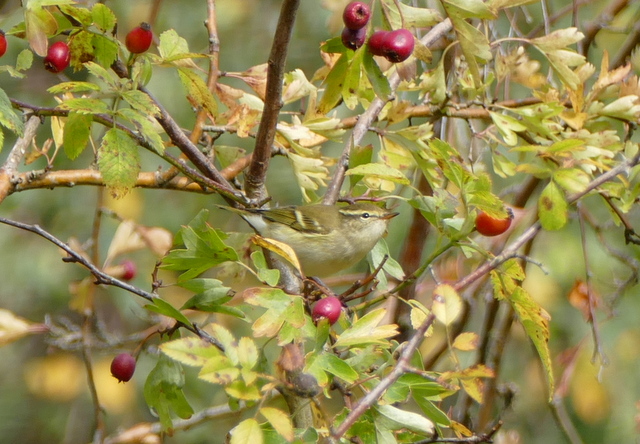 Yellow-browed Warbler – here’s one from Wells earlier in the week
Yellow-browed Warbler – here’s one from Wells earlier in the week
We drove east along the coast to Cley next. The plan was to get a bit of variety and look for some waders and wildfowl on the reserve there. We parked at the visitor centre and popped into Bishop Hide quickly before lunchtime. We could hear a Water Rail squealing from deep in the reeds, not unlike a young pig, as we walked along the path. In front of the hide, we could hear two Water Rails – one squealing either side of us.
We could hear Bearded Tits as well, ‘pinging’ from the reeds outside the hide, but they were rather elusive. We saw them fly a couple of times. A smart male Marsh Harrier was easier to see, quartering the reedbed. It flew towards us, before hovering and dropping down into the reeds.

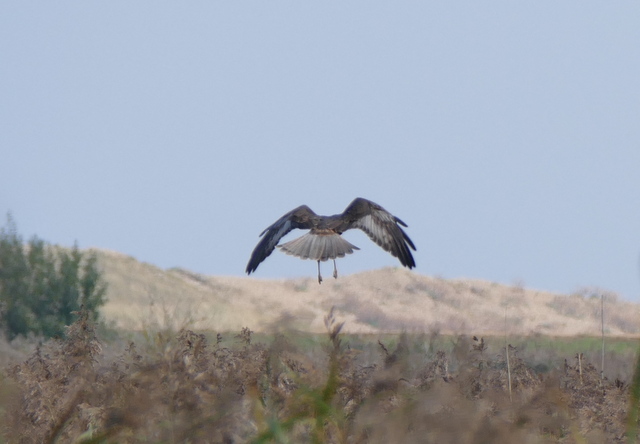 Marsh Harrier – flew past and hovered before dropping into the reeds
Marsh Harrier – flew past and hovered before dropping into the reeds
The water levels are still quite high on the reserve, which has really hindered the variety of waders here in recent weeks, though it is better than it was. There were a couple of Dunlin out on Pat’s Pool, but more larger waders again – several Black-tailed Godwits and Ruff.
 Black-tailed Godwit – feeding on Pat’s Pool
Black-tailed Godwit – feeding on Pat’s Pool
The wader highlight was the flock of Golden Plover. There were a few already on the scrape when we arrived, but more flocks proceeded to drop in as we watched. They had come in from the fields for a wash and a brush up – many were bathing and preening.
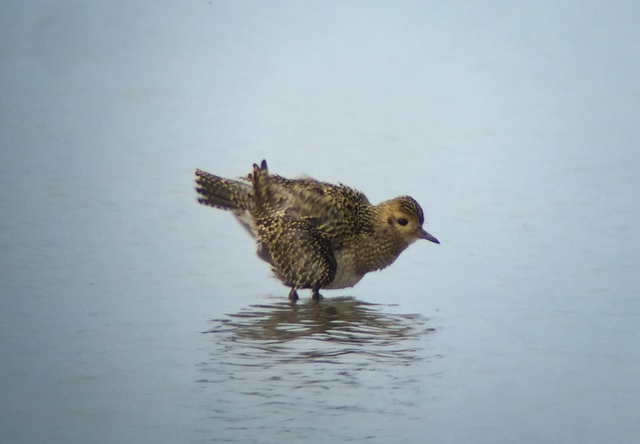 Golden Plover – large numbers dropped in to bathe on Pat’s Pool
Golden Plover – large numbers dropped in to bathe on Pat’s Pool
The Golden Plover seemed settled for a while, but they proved to be very nervous and suddenly all took off for no apparent reason, whirling round in a tight flock, alternately flashing yellow-spangled upperparts and white underparts. It was a recurring theme as we walked around the reserve today – the Golden Plover would drop in for a bit before flushing again and heading off inland.
There were lots of ducks out on Pat’s Pool, particularly Wigeon. We could hear them calling all the time, a pretty whistled ‘wee-oo’. A couple of Pintail dropped in with them, an eclipse drake just starting to moult into breeding plumage again, and a female. Another flock of 13 Pintail circled over, but appeared to drop down on North Scrape instead. There were plenty of Teal and Shoveler too, with a few of the drakes now starting to look much smarter, as they also moult out of eclipse.
It was getting on by now, so we decided to make our way back to the visitor centre for a late lunch. On our way back along the path, we saw a group of six Bearded Tits fly in and drop into the reeds. Even better, two females worked their way up the stems and sat in the tops, in full view, before flying off further out into the reedbed. We could hear another Bearded Tit calling from the reeds by the path further along, so we walked up to it. It was calling quietly no more than a couple of feet from us – we could see the reeds moving – but unfortunately it wouldn’t show itself until it flew off calling.
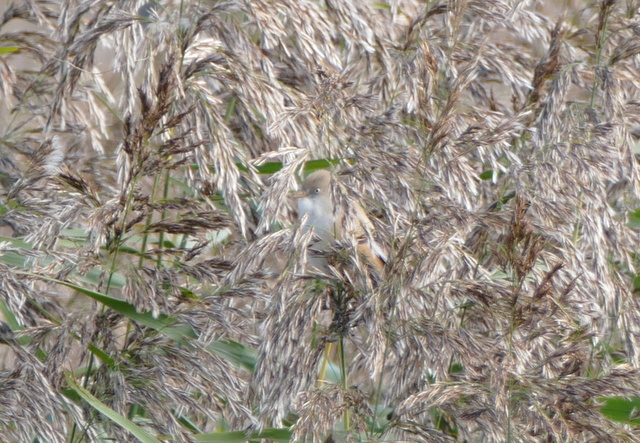 Bearded Tit – one of two females which perched up in the tops of the reeds
Bearded Tit – one of two females which perched up in the tops of the reeds
After lunch, we walked out to the main complex of hides. It was warm now in the sunshine and the insects were out. A Common Darter basked on the boardwalk and a Migrant Hawker flew along the ditch next to the path.
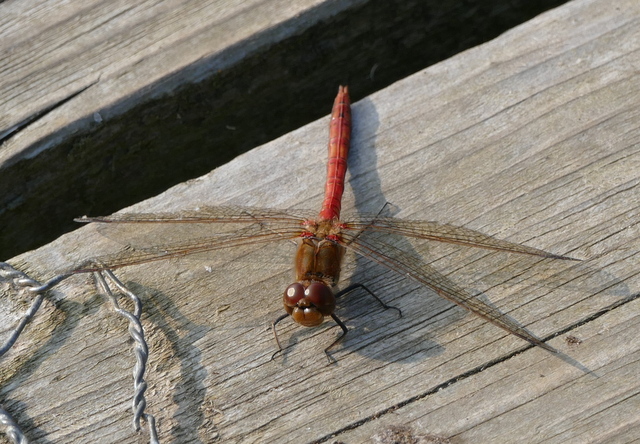 Common Darter – basking on the boardwalk
Common Darter – basking on the boardwalk
We had seen a couple of Greenshank drop into Simmond’s Scrape earlier, from over in Bishop Hide, so we hoped there might be more waders on here today. There was no sign of the Greenshank but there were a few more Dunlin on there, plus more Ruff and Black-tailed Godwit. A Common Snipe flew up from the back of the scrape, circled round and dropped back down into the grass along the edge. We could see it feeding, tucked into the vegetation. A second Snipe was preening in the taller grass on the edge of one of the islands.
There were a couple more Marsh Harriers out over the reeds. First a female flew past – mostly dark brown but with a pale head and yellowish patches on the leading edge of the innerwing. Later a juvenile flew across as well – darker brown then the female and lacking the pale patches in the wings.
We eventually made our way back, stopping to admire a large flock of Goldfinch dropping down to feed on the seeding thistles on the grazing marshes. We had seen a noisy flock of House Sparrows in the bushes by the car park at lunchtime and now they were all gathered in a hawthorn by the path, enjoying the afternoon sunshine.
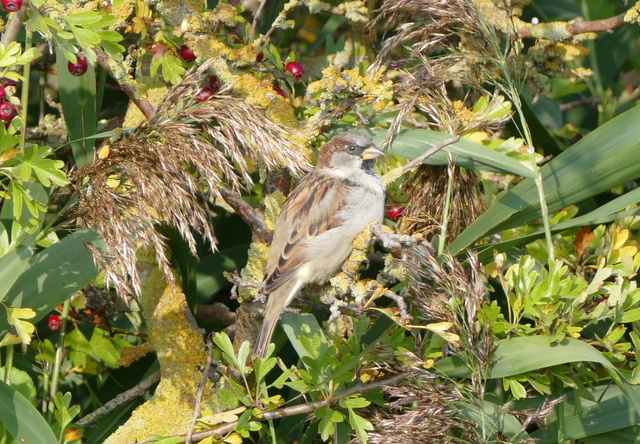 House Sparrow – a noisy flock was enjoying the sunshine
House Sparrow – a noisy flock was enjoying the sunshine
Our next stop was round at the beach car park. A Leach’s Petrel had been reported past Salthouse and the East Bank earlier, but the assembled throng of seawatchers at this end had been disappointed – it hadn’t made it this far. We joined them for a while and scanned the sea. There was a steady stream of Gannets flying east, mostly dark, slatey grey juveniles. Several Guillemots were on the sea, pale-headed in winter plumage now.
We continued to scan the sea as we walked east along the beach. A Mediterranean Gull flew over the beach and dropped down towards the sea, where we got it in the scope. It was a second winter – mostly very pale grey/white like an adult, but with some black flecks in the wing tips. A Razorbill was fishing just offshore nearby, diving constantly. A few Sandwich Terns were still patrolling offshore – the bulk of the breeding birds appear to have left for warmer climes already. An Arctic Skua flew past low over the sea. Several little groups of Brent Geese flew in over the sea, presumably just on their way in from Russia for the winter.
Not far along the beach we could see three photographers standing in a cluster with their lenses pointed down at the shingle in front of them. We went over to join them and could see the subject of their photographic efforts. A Snow Bunting was feeding on the weedy vegetation. It was ridiculously tame – approaching us to within a couple of metres at one point. It appeared to be a 1st winter male, so perhaps it had never seen a human before?
 Snow Bunting – a very confiding individual, feeding on the shingle
Snow Bunting – a very confiding individual, feeding on the shingle
It fed along the old path, in and out of the vegetation at first. Then it hopped out onto the shingle and sat enjoying the late afternoon sunshine, looking at us from time to time but totally unaffected by our presence and the clicking of cameras. We stood and marvelled at it for a while. It was almost too close to focus the scope on it, but looking through we could see amazing details of every individual feather. What a lovely bird and a fitting way to end the day.
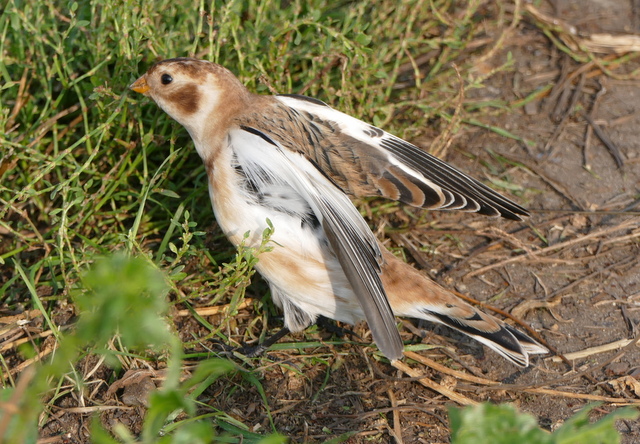 Snow Bunting – flashing the white in its wings as it stretched its wings
Snow Bunting – flashing the white in its wings as it stretched its wings
















